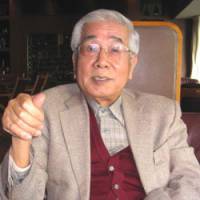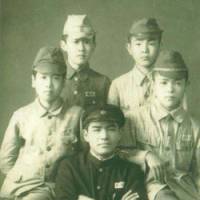The city has long been rebuilt and moved on, but Hiroshi Ito still can't come to grips with Nagasaki's obliteration by the United States 63 years ago.
"I don't have any hatred toward the U.S. now," the 78-year-old A-bomb survivor said, rubbing burn scars on his right hand. "But I do wonder how the U.S. could justify dropping the atomic bomb on us."
As the plutonium bomb "Fat Man," so-named because of its spherical shape, fell over Nagasaki on Aug. 9, 1945, Ito was leaving a friend's house some 1.4 km from ground zero. The blast vaporized the core of the city and outright or in the next few months caused 74,000 deaths.
"It was a blinding flash of light coming from the sky," Ito told The Japan Times. "Then came the heat. It felt like molten steel poured on my body."
Those who witnessed and survived the atomic bombings of Hiroshima and Nagasaki — defining moments in modern warfare — are dying off as time passes, leaving little but rough film footage and Hollywood re-enactments to tell the tale.
But for those who survived the first nuclear attacks on civilization, the shock waves persist.
Born in August 1931, Fukuoka-native Ito moved to Nagasaki with his family when he was in his teens after his father was hired as a technician at a local coal mine. Japan was well on the way to losing the war and the Imperial army was in tatters, but Ito said many believed the nation could still emerge victorious.
"We trained to fight the enemy with bamboo spears and swords. Surrender wasn't an option. It was either kill or be killed," Ito said, recalling the mind-set at the time.
The general population, however, was already struggling to survive, living on whatever vegetables they could grow.
Lacking even minimal medical supplies, grated potatoes were applied to Ito's skin to treat his nuclear burns.
On the morning of Aug. 9, 1945, Ito was at an air-raid shelter with friends after being warned of a possible U.S. air raid. The alert was lifted before 11 a.m. and the youngsters, many hired at a Mitsubishi steel mill, were to report to work in the afternoon.
Ito, 14 at the time, was staying at his friend's house, apart from his family. Only his older sister lived within the blast zone, but she survived because she was in a reinforced concrete military factory.
Upon returning to his friend's house for lunch minutes before the attack, Ito heard B-29 bombers approaching the city. The two teens were about to leave for work but decided to check the commotion.
"There was a sudden flash just as I got outside the door, but I don't remember hearing anything when the bomb went off," he said of the split second.
"The heat wave followed the flash and it must have been faster than the speed of sound. I fainted before I heard anything," he recalled.
The impact of the explosion — equivalent to about 21 kilotons of TNT — killed about half of the population in the radius of approximately 1.5 km from the hypocenter.
The magnitude of the blast left only shadows of objects standing between it and nearby buildings. The mushroom cloud turned day into night.
Burn victims were praying on their knees for salvation, Ito recalled.
After regaining conscious, Ito and his friend walked to a nearby hospital. But his friend claimed he was going blind and urged Ito to head home alone.
"Statistics that half of the people in the 1.5 km radius died are pretty accurate," Ito said during the interview. His friend was carried home later that day but died early the next morning from severe burns.
"I lived, but my friend died. He kept asking for water as he was dying," he said.
Ito was severely burned. He laid his survival to the fact that he was wearing a long-sleeved shirt and long pants when the bomb went off. But his burned skin came off easily, "like peeling an onion."
Ito said he experienced two near-death comas and five months of rehabilitation before being able to return to school.
Looking back on the Hiroshima and Nagasaki bombings, Ito said he sees three reasons why the U.S. took the atomic option — to satisfy its desire to use the new weapon; to end the war at once and avoid further casualties; and to menace the Russians with its nuclear capabilities.
But although Japan's attack on Pearl Harbor was "unjust," the U.S. atomic bombings "were crimes against mankind," he said.
"I urge the U.S. to acknowledge its wrongdoing and contribute to the worldwide denuclearization effort," he added.
Ito later studied engineering at Kyushu University, married in 1957 and began working for a research institute at Fukuoka-based Nippon Tungsten Co. The powder metallurgist also taught at Kurume College of Technology before retiring in 1994.
"For some reason, I haven't had any aftereffect from the exposure," he said. "I feel very fortunate for that."
During his active years, Ito served as vice president of Nihon Hidankyo, the only nationwide organization of nuclear bomb survivors, and on the boards of many other local A-bomb survivor groups.
One such organization, Nagasaki no Shogen no Kai (Association for Testimonies in Nagasaki), is set to publish an English version of A-bomb survivor testimony early next spring.
But the global denuclearization movement remains ineffective, Ito said, and, surprisingly, noted he wants the government to discuss the nuclear option.
"Denuclearization activists tend to misinterpret their tasks as just saying 'no' to nuclear weapons. That could satisfy their objectives, but the goal should not be to force their opinions (on others) but instead to spread the ideal," he said.
If the government were to consider going nuclear, it will bring every issue to the table for thorough discussions. Such an opportunity could be used to clarify why atomic weapons must be eliminated.
"The debate will spell out the procedures required to eradicate nuclear bombs," Ito said.
The retired engineer still recalls the events of August 1945, especially on steamy summer days. He took his seven grandchildren to the site where he was struck, and intends to pass on the dreadful experience to the next generation.
"Our responsibility is to relate the experience to our children and those who are not aware of the dangers of nuclear weapons," Ito said. "Although it is not an easy task to reach out to younger generations, we must spread our message" of nonproliferation, he added.
In this series, The Japan Times interview firsthand witnesses of Japan's march to war and ensuing defeat who wish to pass on their experiences to younger generations. This is the 22nd installment of the Witness to War series. To read more, the Witness to War archive.




